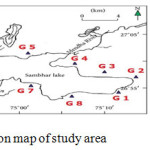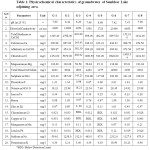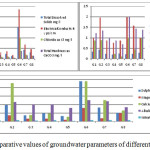Physico-Chemical Analysis of Groundwater Quality of Adjoining Areas of Sambhar Lake, A Ramsar Wetland of Rajasthan, India
A. H. Bhat1 * and K. C. Sharma1
Corresponding author Email: aamirbhatenv@gmail.com
DOI: http://dx.doi.org/10.12944/CWE.10.3.37
Water is not only essential for drinking but also needed for agriculture and industrial use. However, for safe and sustainable use of water for any sector, its quality is to be ensured. Therefore, the study was carried out for water quality of samples collected from different sites in the Lake periphery as well as in the catchment areas. Groundwater samples were collected from different locations of Sambhar Lake city and its adjoining area for their physico-chemical studies. The standard methods of APHA were used to analysis 8 samples collected from hand pumps, bore wells and tube wells of the specified area. The analytical results show pH varies between 7.4-8.6, Electrical conductivity between 1723 µs/cm-23400 µs/cm, Total hardness between 402.0 mg/l-3657.0 mg/l, Calcium between 103.21 mg/l-943.43 mg/l, Alkalinity between 309.69 mg/l-496.92 mg/l, Chloride between 543.0 mg/l-9926.0 mg/l, Magnesium 35.11 mg/l-316.0 mg/l, Total dissolved solids between 1175 mg/l-14900 mg/l, Sulphate between 117.6 mg/l-943.98 mg/l, Fluoride between 0.69 mg/l-2.01 mg/l, Nitrate between 7.69 mg/l-28.45 mg/l, Iron between 0.19 mg/l-0.42 mg/l, Boron between 0.76 mg/l-1.98 mg/l, Zinc between 0.01 mg/l-0.97 mg/l, Chromium between 0.012 mg/l -0.033 mg/l, Copper between 0.037 mg/l -0.065 mg/l, Manganese between 0.11 mg/l-0.97 mg/l, Lead 0.011 mg/l-0.12 mg/l, Sodium 67.0 mg/l -2312.0 mg/l, Potassium 3.40 mg/l -18.90 mg/l.
Copy the following to cite this article:
Bhat A. H, Sharma K. C. Physico-Chemical Analysis of Groundwater Quality of Adjoining Areas of Sambhar Lake, A Ramsar Wetland of Rajasthan, India. Curr World Environ 2015;10(3) DOI:http://dx.doi.org/10.12944/CWE.10.3.37
Copy the following to cite this URL:
Bhat A. H, Sharma K. C. Physico-Chemical Analysis of Groundwater Quality of Adjoining Areas of Sambhar Lake, A Ramsar Wetland of Rajasthan, India. Curr World Environ 2015;10(3). Available from: http://www.cwejournal.org/?p=12876
Download article (pdf) Citation Manager Publish History
Select type of program for download
| Endnote EndNote format (Mac & Win) | |
| Reference Manager Ris format (Win only) | |
| Procite Ris format (Win only) | |
| Medlars Format | |
| RefWorks Format RefWorks format (Mac & Win) | |
| BibTex Format BibTex format (Mac & Win) |
Article Publishing History
| Received: | 2015-08-20 |
|---|---|
| Accepted: | 2015-09-10 |
Introduction
During the past three decades, because of increased small and large scale industries in the country along with increasing population, there is a pressure on ground water resources.1 It has been observed that nearly 10% of population is devoid of safe drinking water.2 In India more than 90% of population of several states is dependent on groundwater resource for drinking and other purposes.3 Presently groundwater is a source used for agricultural and industrial sector.4 Speedy increase in industrialization and urbanization leads to deterioration in the quality of groundwater.5 In order to enhance industrial and agricultural productivity, the groundwater has been over exploited through bore well. This has led decrease in groundwater level. The contamination of groundwater has also been reported at certain sites.6 Rajasthan state is characterized by high evaporation, extreme variations in the temperature low and erratic rainfall. Average rainfall in Jaipur district is 350.5 mm and therefore, it is categorized as arid zone. Due to shortage of water in these arid and semi arid areas, it is imperative to know the quality of ground water as the surface water sources are scrimpy. The character of ground water is the outcome of all the reaction and process that act on the water from the moment, it condenses in the atmosphere to the time, it is discharged by a well.7 The quality of water is of main concern for human beings since it is directly linked with their welfare. Therefore, quality of water is most important aspect of water management.8 The main objectives of the physicochemical study is to know the distribution of solutes in ground water, and the suitability of the groundwater for domestic, agriculture and salt making purpose.
Study Area
Sambhar Salt Lake is the India’s largest saline Lake lying at a latitude and longitude of 26°55'12"N and 75°12'00"E respectively. The Lake is elliptical in shape running about 22 km in length and is surrounded on all sides by Aravali mountain ranges. Sambhar Lake is designated as a Ramsar site (wetland of international importance No. 464 March 1990), and Important Bird and Biodiversity area (IBA site No. IN-RJ-1) as it is key wintering area for thousands of flamingos and other migratory birds from northern Asia. It occupies an area of approximately 230 km2 with width varying from 3 to 11 km. The average depth of water in Lake is 1 m in dry season and maximum depth is 3 m which is achieved during the monsoon season. Mendha and Rupangarh are the two major streams that feed water in the Lake along with many rivulets and surface runoff.9 From traditional times the Sambhar Lake is used for the production of salt. It has made Rajasthan the third largest salt producing state in India producing 196,000 tonnes of clean salt per year that is equal to 8.7 % of India’s total salt production. The traditional process of extracting salt from Sambhar Lake was monsoon dependent. However, today salt is produced mainly on the eastern side, with modern technology supported by the traditional methods. Deep bore wells are now used at salt production units to extract groundwater. The presence of salt Lakes and saline groundwater aggravate the availability of potable water supply for domestic, agricultural and industrial purposes.
The stake holders and general public must be aware about the quality of water being used for different purposes. As such the information is also important for concerned government officials and policy makers regarding water distribution and its management. In view of ground water use by a large size of population in the area, the present study on ground water quality of adjoining areas of Sambhar Lake was carried out to assess physicochemical parameters such as pH, Electrical conductivity, Total hardness, Total dissolved solids, Calcium, Alkalinity, Chloride, Magnesium, Sulphate, Fluoride, Nitrate, Iron, Boron, Zinc, Chromium, Copper, Manganese, Lead, Sodium, Potassium. The groundwater samples were collected from eight different locations around Sambhar Lake. The ground water from hand pump (G4, G5) is used for domestic purpose and drinking, tube well (G1,G2,G3,G7,G8) is used for agriculture and bore well (G6) is used for salt making (Fig. 1).
 |
Figure 1: Location map of study area Click here to View figure |
Materials and Methods
Groundwater samples from different hand pumps, tube wells and bore wells at 8 sampling points were analyzed. Water samples were collected in cleaned and washed glass bottles and brought to the laboratory for analysis. Physical parameters like pH, total dissolved solids (TDS), and electrical conductivity (EC) were determined at site with the help of digital portable meters (Hanna, Italy). The selected water samples were collected labeled and were brought in to laboratory, analysis was done by adopting standard methods given in APHA.10 Water used for preparation of solutions was double distilled and reagents used for the analysis were of AR grade.
 |
Table 1: Physicochemical characteristics of groundwater of Sambhar Lake adjoining area. Click here to View table |
 |
Figure 2: Comparative values of groundwater parameters of different sites. Click here to View figure |
Result and Discussion
Among all the Eight different sampling locations it reveals that the water sample G6 has the highest concentration of all parameters checked except PH, Iron, Zinc and Chromium which were found highest in water samples of G5,G2,G8 and G2 respectively. This is the reason that the water from this G6 bore well is not used for domestic use but only for the salt production and the water is extracted from the deeper depth. While as the lowest concentration of maximum parameters i,e Electrical conductivity ,Total hardness, Calcium, Alkalinity, Chloride, Magnesium, Total dissolved solids, Sulphate, Fluoride, Nitrate, Zinc, Sodium, checked was found less in the ground water sample collected from site G5 hand pump and water is used for domestic purpose by the people in that area. The pH value was lowest in G6. Iron, Boron, Chromium value was found lowest in G4. The lowest concentration of Copper, Manganese,Lead and Potassium were reported in G7,G3,G1 and G3 respectively.
Conclusion
Analysis of groundwater samples collected from the study area indicates that the water used for drinking purpose is safe for drinking as the water samples were found to be within the permissible limits of drinking water standards given by BIS. But due to less availability of drinking water people are compelled to drink contaminated water or rely on tankers for drinking water. It is therefore recommended that a detailed hydro geophysical study be carried out to determine the depth and availability of ground water to meet the needs of existing population and for effective utilization and evaluation of groundwater resources as a reliable alternative source of water supply.
References
- Ramakrishnaiah CR, Sadashivaiah C and Ranganna G. Assessment of water quality index for the groundwater in Tumkur Taluk, Karnataka State, India. E-Journal of Chemistry 6(2) 523-530(2009).
- Ramesh M, Dharmaraj E and Raj BJR. Physico-chemical characteristics of ground water of Manachanallur Block Trichy, Tamilnadu, India. Advances in Applied Science Research 3(3) 1709-1713(2012).
- Ramachandraiah C. Right to drinking water in India, Centre for Economic and Social Studies 56(2004).
- Ramesh K and Soorya V. Hydrochemical analysis and evaluation of groundwater quality in and around Hosur, Krishnagiri District, Tamil Nadu, India. International Journal of Research in Chemistry and Environment 2(3) 113-122(2012).
- Laluraj, C. M., Gopinath, G., & Dinesh Kumar, P. K.. Groundwater chemistry of shallow aquifers in the costal zones of cochin. India Applied Ecology and Environmental Research, 3(1), 133–139(2005).
- Rao J, Babu H, Swami AVV and Sumithra S. Physico-chemical characteristics of ground water of Vuyyuru, part of East Coast of India. Universal Journal of Environmental Research and Technology 3(2) 225-232(2013).
- Gupta. S, Akhalesh Kumar, C. K. Ojha and Gita Seth. Chemical Analysis of Ground Water of Sanganer Area, Jaipur in Rajasthan, J. Environ. Sci. and Engg., 46 (1), 74-78(2004).
- Shama, S., Iffat, R., Mohammad, I. A. and Safia, A..Monitoring of physicochemical and microbiological analysis of underground water samples of district Kallar Syedan Rawalpindi, Pakistan. Research J. of Chemical Sciences, 1: 24 -30(2011).
- Gopal. B, & Sharma, K. P. Sambhar Lake,Rajasthan. New Delhi: WWF-India(1994).
- APHA, AWWA, WEF. Standard Methods for examination of water and wastewater.22nd ed. Washington: American Public Health Association;, 1360 pp. ISBN 978-087553-013-0(2012).







